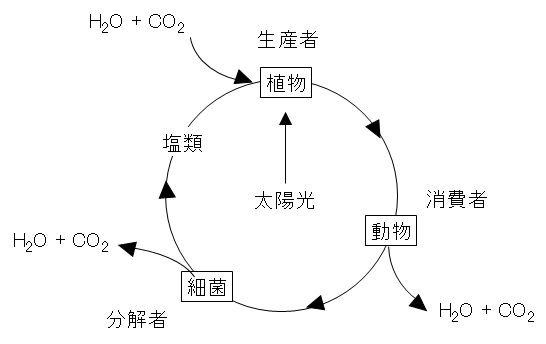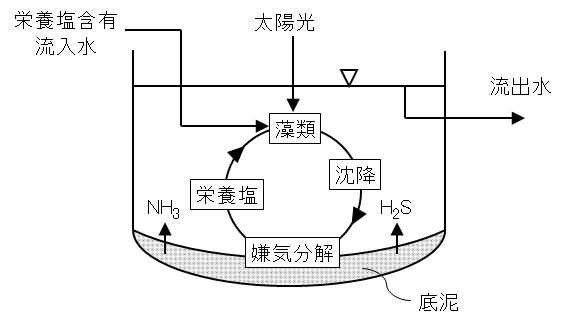Water Use and Environment – Mechanism of Water Pollution
村上定瞭(水浄化フォーラム), Sadaaki Murakami (Water & Solutions Forum)
水質汚濁の機構
流水の中に流入した物質が、環境の条件に支配されながら環境水質を汚濁する過程は、多種多様な要因と複雑な相互関係がある。流入物質は水の運動に伴う空間的移動の結果、汚濁した水環境を形成する。その移動過程の時間的経過の中で、物質変化が進み、流水の水質は変化していく。流入する物質の量とこれを受け入れる水環境の状況により汚濁の程度が決まり、流入する物質の量が過度になると水質汚濁が発生する。
水質汚濁とは、毒物による一方的な障害は別として、ものによっては水質改善に向かう一時的な過程でもある。このような水質汚濁の現象とその原因となる物質との因果関係、また物質移動の様相、物質変化のメカニズムなどを把握することが水質汚濁の対策の上で大切である。
Mechanism of water pollution
The process of polluting the environmental water quality of substances flowing into running water under the control of environmental conditions has a complicated interrelationship with various factors. Influent materials form a polluted water environment as a result of spatial movement associated with water movement. During the time course of the migration process, the material changes and the quality of the running water changes. The degree of pollution depends on the amount of substances flowing in and the conditions of the water environment that receives them, and if the amount of substances flowing in becomes excessive, water pollution will occur.
Water pollution is a temporary process for improving water quality, apart from one-sided obstacles caused by poisonous substances. It is important for countermeasures against water pollution to understand the causal relationship between the phenomenon of water pollution and the substances that cause it, the aspect of mass transfer, and the mechanism of material change.
物質循環と生物作用
水は、気体・液体と形を変えながら地球上を循環して、瞬時も静止していない。水は循環している間に様々な働きをするが、重要な機能は物質の運搬である。地表面を流れる水は、土砂や溶解塩類を運び、海に蓄える。生物は、水を体内に取り込むと同時に必要な物質を摂取し、成長し、生活のエネルギーを得ている。
自然界の中では、図1に示すように常に生物を介して物質の生産と消費・分解が行われおり、ある平衡が保たれている限り、生態系の維持は健全である。しかし、人為的な介入が極端に大きくなったり、生態系の構造を無視するような作用を加えると、たちまちにして破壊に向かって変化が起こる。このような状態が水質汚濁である。
例えば、河川に有機物が流入したとする。しばらくして、この有機物を栄養源として細菌類が繁殖する。この有機物の量が少量であれば、細菌類に分解されて再び川は元の状態に戻り、これを自浄作用と呼んでいる。しかし、自浄作用の効く範囲を超えると、川は嫌気状態となり、メタン、二酸化炭素とともに硫化水素、アンモニアなどのガスが発生して、いわゆる死の川となり深刻な水質汚濁が発生する。
Material cycle and biological action
Water circulates on the earth while changing its shape to gas and liquid, and is not stationary for a moment. Water performs various functions while circulating, but the important function is the transportation of substances. Water flowing on the ground surface carries sediment and dissolved salts and stores it in the sea. Organisms take water into their bodies and at the same time ingest necessary substances to grow and obtain energy for life.
In the natural world, as shown in Fig.1 , the production, consumption and decomposition of substances are always carried out through living organisms, and the maintenance of the ecosystem is sound as long as a certain equilibrium is maintained. However, when human intervention becomes extremely large or when it acts by ignoring the structure of ecosystems, changes occur immediately toward destruction. Such a state is water pollution.
For example, suppose organic matter flows into a river. After a while, bacteria propagate using this organic matter as a nutrient source. If the amount of this organic matter is small, it will be decomposed into bacteria and the river will return to its original state, which is called self-recovery action. However, when the self-recover action is exceeded, the river becomes anaerobic, and gases such as hydrogen sulfide and ammonia are generated together with methane and carbon dioxide, which causes a so-called dead river and serious water pollution occurs.

図1 生態系における物質循環 Fig.1 Material cycle in ecosystem
川の自浄作用
流水の自浄作用とは、汚濁した水が時間的経過と空間的移動の間に、汚濁物質が減少して清水に近づくことを意味する。自浄作用を作用機構から次のように分けられる。
(1)物理的作用:支流などから流入する清水により希釈、大量の水中への拡散、混合、沈殿、ろ過による汚濁物質の除去、揮発性物質の大気中への揮散などによって汚濁物質が減少する。
(2)化学的作用:光、酸素、オゾン、落雷等による酸化・還元作用、酸化性あるいは還元性物質による酸化還元反応、底質物質への吸着、物質相互間の化学反応、凝集などによって汚濁物質の減少が起こる。
(3)生物的作用:微生物、プランクトン、水生植物、魚類など水生生物による摂取・代謝分解により汚濁物質が除かれる。
Natural recovery action in river
The self-purification action of running water means that polluted substances decrease and polluted water approaches original clean water during the passage of time and spatial movement. The self-purification action can be divided as follows from the action mechanism.
(1) Physical action: Diluted by fresh water flowing in from a tributary, diffusion into a large amount of water, mixing, precipitation, removal of pollutants by filtration, volatilization of volatile substances into the atmosphere, etc..
(2) Chemical action: Oxidation / reduction action due to light, oxygen, ozone, lightning, etc., redox reaction due to oxidizing or reducing substances, adsorption to sediment substances, chemical reaction between substances, aggregation due to agglomeration, etc. Material loss occurs.
(3) Biological effects: Pollutants are removed by ingestion and metabolic decomposition by aquatic organisms such as microorganisms, plankton, aquatic plants and fish.
地下水の汚染
地下水は地表水と異なり流れが緩やかである。さらに、水の流れの方向が把握し難く、水平方向に加えて深さ方向への流動もあるため、汚染源の特定、影響の及ぶ範囲の予測が極めて困難である。汚染物質の流入に対して、流量が少ないため希釈効果が働かない。揮発、吸着などの系外排除、酸化・還元分解、光分解、生物分解などの自浄機能が働きにくい。地下水中での汚染物質の挙動が複雑かつ不明確で、その解明には多大の労力、時間、費用が必要である。
地下水汚染が発見されたとき、汚染状態が長期にわたって継続するため、汚染した時期を過去にさかのぼって明確にすることが難しい。したがって、微量でも汚染された地下水の回復は困難で、その影響は長期にわたり、広範囲に及び危険がある。
Groundwater pollution
Unlike surface water, groundwater flows slowly. Furthermore, since the direction of water flow is difficult to grasp and there is a flow in the depth direction in addition to the horizontal direction, it is extremely difficult to identify the pollution source and predict the extent of influence. Dilution does not work against the inflow of pollutants due to the small flow rate. Self-recovery functions such as volatilization, external exclusion such as adsorption, oxidative / reductive decomposition, photolysis, and biodegradation are difficult to work. The behavior of pollutants in groundwater is complicated and unclear, and it takes a lot of labor, time, and cost to clarify them.
When groundwater pollution is discovered, it is difficult to trace the time of the pollution to the past because the condition of the pollution lasts for a long time. Therefore, it is difficult to recover contaminated groundwater even in a small amount, and its effects are long-term, widespread and dangerous.
富栄養化
富栄養化とは、本来、湖沼中の栄養成分の量が少しずつ増えていくことを意味している。地核変動などよりできた直後の湖は、生物の栄養源がなく、ほとんど純粋に近い状態の水が貯まっているにすぎない。このような生物のほとんどいない貧栄養湖でも、次第に周囲から流水の流入に伴って、栄養塩類が流入し、蓄積され、生物の発生が認められるようになる。生育した生物は死滅して湖底に堆積し、栄養塩類が蓄積し、再び溶出することと新たな供給により、生物が発生と死滅を繰り返すうち、次第にその濃度を高めていき、深かった湖も、生物死がいと土砂の流入が加わり次第に埋まっていき、やがて湿原となり、台地を形成しながら森林地帯へと遷移している。富栄養化現象とは、本来、このような自然の遷移現象をいう。
近年、人の活動が大規模となり、環境水域、特に閉鎖性水域においては、この栄養状態のよくなる速度が加速し、過度に栄養状態がよくなった。図2に示すように栄養塩類が閉鎖性水域に流入すると藻類の繁殖が起こり、これが底に沈積して嫌気性生物分解により栄養塩類が溶出し、これが再び藻類の繁殖が引き起こされる。このようにして流入した栄養塩類が蓄積し累進的に水質が悪化し、魚類の斃死(へいし)や水道水の異臭など利水上の障害が生じるようになってきた。
湖沼や内湾などの閉鎖性水域に窒素やリンなどの栄養塩類が豊富になり、これをもとにして植物プランクトンや藻類が繁殖し、動植物プランクトンや魚介類が豊になる現象を富栄養化という。水域の生産性向上という観点では好ましい現象である。しかし、栄養塩類の流入量が過剰になると、水質や底質は悪化し、生物相が単調となって悪質なアオコ(水の華)や赤潮が発生するようになる。さらに進行すると、細菌類と原生動物だけが活動する腐水状態になり、悪臭を発生するようになる。生活排水や産業排水が流入し、水が停滞しやすい水域では栄養塩類が過剰になりやすい。
Eutrophication
Eutrophication essentially means that the amount of nutrients in a lake gradually increases. Immediately after the formation of the Earth’s core, the lake has no nutrient source for living organisms, and it stores almost pure water. Even in such an oligotrophic lake where there are few living organisms, nutrient salts gradually flow in from the surroundings, and nutrient salts flow in and accumulate, and organisms can be generated. The living organisms die and are deposited on the bottom of the lake, nutrients accumulate, elute again and by new supply, while the organisms repeatedly generate and die, their concentration gradually increases, deep lakes, It gradually fills up due to the addition of biological mortality and inflow of earth and sand, and eventually becomes a marshland, forming a plateau and transitioning to a forest area. The eutrophication phenomenon originally means such a natural transition phenomenon.
In recent years, human activities have become large-scale, and in environmental waters, especially in closed waters, the rate of improvement of nutritional conditions has accelerated, and nutritional conditions have become excessively good. As shown in Fig.2 , when nutrients flow into the closed water area, algae breeds, which deposits on the bottom and elutes nutrients by anaerobic biodegradation, which causes algae breeding again. In this way, the nutrient salts that have flowed in are accumulated and the water quality progressively deteriorates, causing water damage such as death of fish and the offensive odor of tap water.
Eutrophication is a phenomenon in which nutrient salts such as nitrogen and phosphorus are abundant in closed water areas such as lakes and bays, and phytoplankton and algae are propagated based on the nutrient salts, resulting in rich flora and fauna and seafood. .. This is a preferable phenomenon from the viewpoint of improving the productivity of water bodies. However, if the inflow of nutrients becomes excessive, the water quality and bottom quality will deteriorate, and the biota will become monotonous, causing malicious blue-green algae and red tides. As it progresses further, only bacteria and protozoa are put into a humorous state, and a foul odor is generated. Domestic water and industrial waste water flow in, and nutrients are likely to become excessive in water areas where water tends to stagnant.

図2 閉鎖系水域の富栄養化の機構 Fig.2 Mechanism of eutrophication in closed waters
生物濃縮
生物はすべて、生息する環境に存在する物質を、必要の有無にかかわらず取り入れる。水中の魚類は餌として補食した物に含まれて、種々の不要物質を取り込むほか、えら、うろこなどの体表からも水中の物質を取り込む。水生植物も、根、茎、葉から種々の物質を取り入れる。しかも、吸収と排泄の速度によって蓄積量が決まるが、一般に環境水中の濃度より、生物体内の濃度が高いことが多い。ここで、生物体内の物質の濃度とその生物の生息する環境水中のその物質の濃度との比を濃縮比又は濃縮係数という。
環境から生物へ、被食生物から補食生物へという流れの中で、有害物質は次第に体内での存在比が大きくなる。まず水中の栄養源から生産者である植物プランクトン、藻類、水生植物が繁殖する。これを消費者である動物プランクトン、草食動物が補食し、この動物を高次の消費者である肉食動物が補食する。この関係を食物連鎖という。人は、この食物連鎖の過程で常に最高次の位置付けられる。特に、自然界からの食物である魚介類は、濃縮比において最も高いものである。したがって、有害物質の環境中での濃度が微量でも、ダイオキシンに代表される塩素系有機化合物などのように難分解性で生物による濃縮係数の高い物質は食物連鎖の過程で累進的に濃縮され、高次に位置する動物や人に重大な障害をもたらすこととなる。
Bio-magnification
All living organisms take in substances that are present in their environment, whether or not they are needed. Fish in water are contained in foods that are eaten as food, and in addition to taking in various unnecessary substances, substances in water are also taken in from body surfaces such as gills and scales. Aquatic plants also incorporate various substances from roots, stems and leaves. Moreover, the amount of accumulation is determined by the rate of absorption and excretion, but in general, the concentration in organisms is often higher than the concentration in environmental water. Here, the ratio between the concentration of the substance in the organism and the concentration of the substance in the environmental water in which the organism inhabits is called the concentration ratio or concentration factor.
The abundance ratio of harmful substances in the body gradually increases as the environment moves from organisms to prey and predators. First, phytoplankton, algae, and aquatic plants, which are producers, propagate from nutrients in water. Consumers such as zooplankton and herbivores feed on this, and higher-level consumers, carnivores, feed on this animal. This relationship is called the food chain. People are always ranked highest in the process of this food chain. In particular, seafood, which is a food from the natural world, has the highest concentration ratio. Therefore, even if the concentration of harmful substances in the environment is very small, substances such as chlorine-based organic compounds represented by dioxins that are difficult to decompose and have a high concentration factor by organisms are progressively concentrated in the food chain process, This will cause serious damage to animals and humans at the higher levels.
